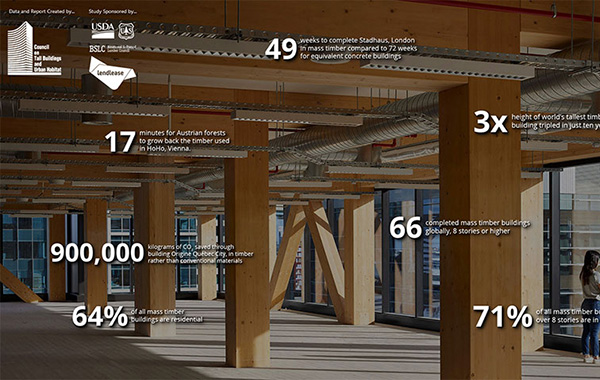Filter by
You must be a CTBUH Member to view this resource.

Mjøstårnet
Wood Hotel by Frich's, Mjøs tower
Building
Completed
2019
Residential / Hotel / Office
All-Timber
85.4 m / 280 ft
18
1
33
72
175
3
2.5 m/s
11,300 m² / 121,632 ft²
Proposed
Construction Start
Completed
The Design Engineer is usually involved in the front end design, typically taking the leadership role in the Schematic Design and Design Development, and then a monitoring role through the CD and CA phases.
The main contractor is the supervisory contractor of all construction work on a project, management of sub-contractors and vendors, etc. May be referred to as "Construction Manager," however, for consistency CTBUH uses the term "Main Contractor" exclusively.
Other Consultant refers to other organizations which provided significant consultation services for a building project (e.g. wind consultants, environmental consultants, fire and life safety consultants, etc).
Material Supplier refers to organizations which supplied significant systems/materials for a building project (e.g. elevator suppliers, facade suppliers, etc).
You must be a CTBUH Member to view this resource.
Usually involved in the front end design, with a "typical" condition being that of a leadership role through either Schematic Design or Design Development, and then a monitoring role through the CD and CA phases.
The Design Engineer is usually involved in the front end design, typically taking the leadership role in the Schematic Design and Design Development, and then a monitoring role through the CD and CA phases.
The Design Engineer is usually involved in the front end design, typically taking the leadership role in the Schematic Design and Design Development, and then a monitoring role through the CD and CA phases.
The CTBUH lists a project manager when a specific firm has been commissioned to oversee this aspect of a tall building’s design/construction. When the project management efforts are handled by the developer, main contract, or architect, this field will be omitted.
The main contractor is the supervisory contractor of all construction work on a project, management of sub-contractors and vendors, etc. May be referred to as "Construction Manager," however, for consistency CTBUH uses the term "Main Contractor" exclusively.
Other Consultant refers to other organizations which provided significant consultation services for a building project (e.g. wind consultants, environmental consultants, fire and life safety consultants, etc).
Material Supplier refers to organizations which supplied significant systems/materials for a building project (e.g. elevator suppliers, facade suppliers, etc).
2021 CTBUH Awards
2022 CTBUH Awards
14 March 2019 - CTBUH News
22 January 2019 - CTBUH News

01 October 2020 | Brumunddal
Building the World's Tallest Mass Timber Building: Mjøstårnet in Brumunddal, Norway

05 July 2023
Nima Zahiri
Timber high-rises have emerged as an innovative and sustainable solution for vertical urban development, with the Nordic countries leading the way in their implementation. This...

14 March 2019
The Council on Tall Buildings and Urban Habitat (CTBUH) has verified the completion of Mjøstårnet, a mixed-use building in Brumunddal, Norway that now holds the...
The design concept of Mjøstårnet was inspired by the Paris Agreement to combat climate change and began as an idea to reduce carbon dioxide emissions while sustainably sourcing construction materials locally.
All key structural components of Mjøstårnet are composed of engineered timber, utilizing glue-laminated timber for beams and columns and cross-laminated timber for the core walls containing the building’s elevator and stairway shafts. The glue-laminated columns were fabricated with pre-drilled holes and assembled onsite into vertical trusses of up to five floors in height, providing stability to horizontal and vertical forces. Floor slabs for levels 11 and below are also crafted from timber beams, topped with laminated veneer lumber and a thin 50-millimeter layer of concrete for acoustical and vibrational performance, while levels 12 and above have floor slabs fully composed of concrete to increase weight and achieve the desired dynamic behavior in periods of strong winds.
2021 CTBUH Awards
2022 CTBUH Awards

05 July 2023
Nima Zahiri
Timber high-rises have emerged as an innovative and sustainable solution for vertical urban development, with the Nordic countries leading the way in their implementation. This...

23 May 2022
CTBUH Research
This data study represents the significant recent momentum of the mass-timber movement worldwide. There are now 139 mass timber buildings around the world of eight...

04 April 2022
Daniel Safarik, Jacob Elbrecht & William Miranda, CTBUH
The past few years have seen tremendous interest in the development of mass timber buildings of increasing height, in urban settings, many of which are...
14 March 2019
CTBUH has verified Mjøstårnet in Brumunddal, Norway, as the “World’s Tallest Timber Building,” rising at 85.4 meters.
22 January 2019
Check out our monthly predictions based on our industry intelligence to see what trends and milestones will shape the industry in the year to come!
29 October 2017
Delegates gathered in the offices of Arup in Sydney to participate in the Tall Timber Workshop, which included 14 presenters speaking on topics relevant to the tall timber industry.
Subscribe below to receive periodic updates from CTBUH on the latest Tall Building and Urban news and CTBUH initiatives, including our monthly newsletter. Fields with a red asterisk (*) next to them are required.
View our privacy policy